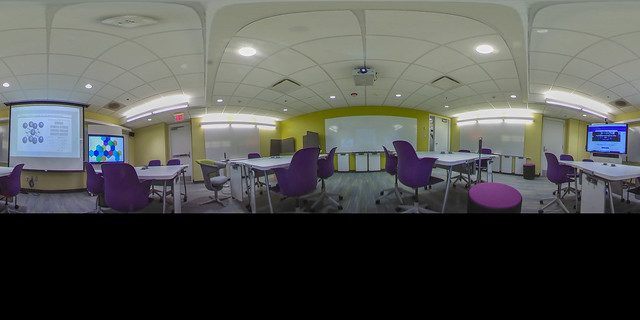The Farley Center for Entrepreneurship and Innovation takes its name seriously. And not just in the engagement opportunities they provide or the content of their courses, but even in the way their material is presented to students.
Every Tuesday and Thursday afternoon during the spring quarter, Northwestern undergraduates assemble in San Francisco and Evanston to attend the same class, Global Silicon Valley. Depending on the week, the instructors may be in one location or the other, using telepresence software and a TA stand-in to approximate the in-class experience for either room no matter where they happen to physically be. This approach not only allows students and instructors the flexibility to redefine their classroom experience, but also serves as a ‘practice what you preach’ approach to thinking with an entrepreneurial mindset.
Led by Suzee Han [BA ‘15] and Li Jiang [BA ‘10], Global Silicon Valley provides students exposure to entrepreneurs and investors with a proven track record of building startups. It also instills in them a deep appreciation and understanding for the fundamental trends shaping that world. Or, as Han and Jiang put it, “Ground-zero access to companies that will be relevant in the future.” This immersive experience not only considers the current and future role of technology in our lives, but also where future bets are being placed.
I recently had the opportunity to speak with Ria Hirsch, Senior Program Coordinator for the Farley Center, about her support of the Global Silicon Valley class, its use of active learning spaces, and the growing necessity for action in academia.
The following are quotes from my conversation with Ria.
An Onramp to Entrepreneurship
The Farley Center serves as an onramp to entrepreneurship through a series of experiential learning opportunities for students who are curious but maybe never thought they would pursue it seriously.
Entrepreneurship is really educational praxis. There’s this difference that we often don't want to admit in academia where, until there's some kind of practical field work to necessitate it, the ideas discussed in class may never actually be put into action. In many ways, the University is really trying to improve that, but entrepreneurship doesn't function unless it's doing. Part of that is because what you’re learning is basically how to launch a small business. You could read a couple of books and be like, “Oh, those are the steps,” but nothing will make sense unless you're really building something.
Part of the experience of taking a class through the Farley Center is to give students the ability to understand what it means to do these tasks. If at some point they have an idea they want to present in front of a group of venture capitalists or if they're within a large corporation and want to launch a new idea, they have to know what it's like to really come under fire and still get their message across using the most up-to-date tools available.
Finding the Innovation Lab
In January, I saw this article on the Innovation Lab in the University Library (B183) and I was like, “Yes! We have to check that out.” I wasn't even thinking of classes at that point—I just wanted to see what the University considers to be an innovative classroom. So we sent some team members to scout out the location and the tools and we were really struck by the potential to do interesting things with our faculty and students.
At the end of the quarter, in lieu of final papers or test in our classes, we have final pitches where students have to get in front of not just their class but also high-powered people we invite from industry to judge their ideas and give feedback, sometimes harshly, because you can't grow without it.
Our faculty really wanted a new room for their spring quarter class and decided the final pitches would be a good test run for the Innovation Lab. Everyone ended up loving the space and what it enables students to do—innovate in how they present themselves.
Applying the Entrepreneurial Mindset to Class
My initial understanding of the Global Silicon Valley course was that it was going to be a seminar in San Francisco which would be filmed and that students here would just watch the recordings each week. But after discussion with the faculty, it became clear that the class really needed need to be highly interactive, using Blue Jeans to connect the campuses and an experienced TA to help facilitate discussion. Suzee and Li really wanted the people in Evanston to feel like they are part of the class in San Francisco and vice versa.
Students present and interact with the instructors and their peers in San Francisco from the Innovation Lab in Evanston as if they are in the same room.
The Innovation Lab has worked great for this because it’s a more intimate space and you can play around a little more between the different screens and movable tables as opposed to a traditional classroom. It’s allowed the students in Evanston to interact with speakers in San Francisco and have a really good back and forth because of the tools that that room has and how we've been able to set it up. It’s this kind of robust interface that allows us to take it a step further and plan field trips for the San Francisco cohort where we can virtually bring their Evanston counterparts along with them. Right now we're planning a visit to the Lyft headquarters in San Francisco where we’ll Blue Jeans in the rest of the class so no side is left behind.
The more we explore what the Lab can do with this class, the more we push ourselves on what it means to teach. And the best part is that everything has run smoothly. Feedback from the students has been incredibly positive—they say it's one of the best experiences they’ve had at Northwestern.


